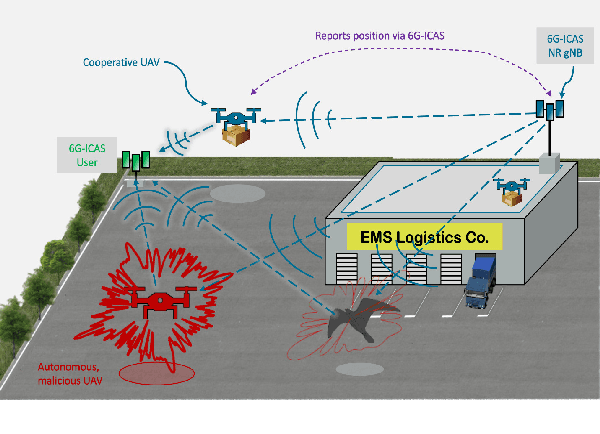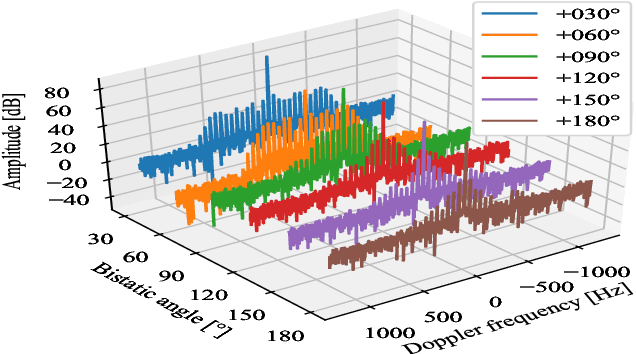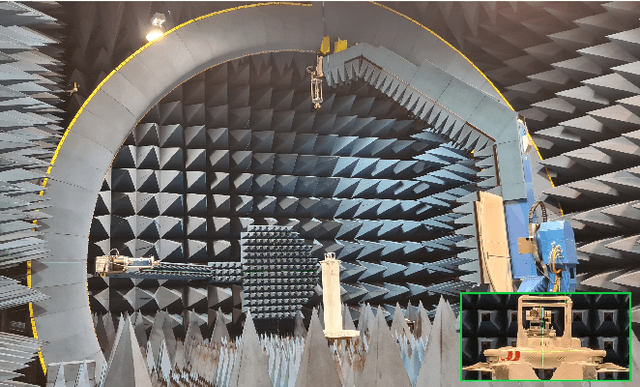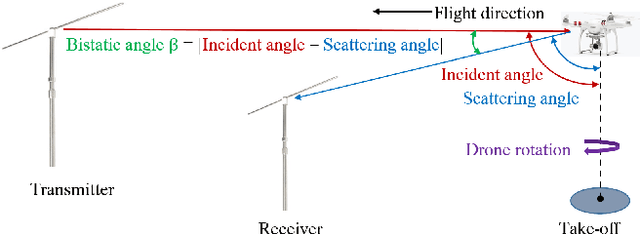Heraldo Cesar Alves Costa
Modeling Micro-Doppler Signature of Multi-Propeller Drones in Distributed ISAC
Apr 07, 2025Abstract:Integrated Sensing and Communication (ISAC) will be one key feature of future 6G networks, enabling simultaneous communication and radar sensing. The radar sensing geometry of ISAC will be multistatic since that corresponds to the common distributed structure of a mobile communication network. Within this framework, micro-Doppler analysis plays a vital role in classifying targets based on their micromotions, such as rotating propellers, vibration, or moving limbs. However, research on bistatic micro-Doppler effects, particularly in ISAC systems utilizing OFDM waveforms, remains limited. Existing methods, including electromagnetic simulations often lack scalability for generating the large datasets required to train machine learning algorithms. To address this gap, this work introduces an OFDM-based bistatic micro-Doppler model for multi-propeller drones. The proposed model adapts the classic thin-wire model to include bistatic sensing configuration with an OFDM-like signal. Then, it extends further by incorporating multiple propellers and integrating the reflectivity of the drone's static parts. Measurements were performed to collect ground truth data for verification of the proposed model. Validation results show that the model generates micro-Doppler signatures closely resembling those obtained from measurements, demonstrating its potential as a tool for data generation. In addition, it offers a comprehensive approach to analyzing bistatic micro-Doppler effects.
Bistatic Micro-Doppler Analysis of a Vertical Takeoff and Landing (VTOL) Drone in ICAS Framework
Feb 12, 2025Abstract:Integrated Communication and Sensing (ICAS) is a key technology that enables sensing functionalities within the next-generation mobile communication (6G). Joint design and optimization of both functionalities could allow coexistence, therefore it advances toward joint signal processing and using the same hardware platform and common spectrum. Contributing to ICAS sensing, this paper presents the measurement and analysis of the micro-Doppler signature of Vertical Takeoff and Landing (VTOL) drones. Measurement is performed with an OFDM-like communication signal and bistatic constellation, which is a typical case in ICAS scenarios. This work shows that micro-Doppler signatures can be used to precisely distinguish flight modes, such as take-off, landing, hovering, transition, and cruising.
Static Reflectivity and Micro-Doppler Signature of Drones for Distributed ICAS
Jan 25, 2024



Abstract:The integration of wireless communication and radar sensing is now getting a huge interest from researchers of two big societies, wireless communication and radar. The road map to the final goal and individual solutions to the challenges might differ in developing the Integrated Communication and Sensing (ICAS) system. However, the electromagnetic signature of the targets will be still valid for all variants of the ICAS system because the detection, localization and classification of the targets are involved. Therefore, this paper presents a study on static reflectivity and micro-Doppler signatures of drones together. To acquire the required data, the state-of-the-art measurement system, BiRa, is used.
Modelling Micro-Doppler Signature of Drone Propellers in Distributed ISAC
Jan 25, 2024



Abstract:Integrated Sensing and Communication (ISAC) comprises detection and analysis of non-cooperative targets by exploiting the resources of the mobile radio system. In this context, micro-Doppler is of great importance for target classification, in order to distinguish objects with local movements. For developing algorithms for target classification, it is necessary to have a large amount of target signatures. Aiming to generate these data, this paper proposes a mathematical model for the micro-Doppler of drone rotating propellers, and validate the proposed model by comparing it to measured micro-Doppler. Results show that the proposed mathematical model can generate micro-Doppler data very similar to those from measurement data.
 Add to Chrome
Add to Chrome Add to Firefox
Add to Firefox Add to Edge
Add to Edge